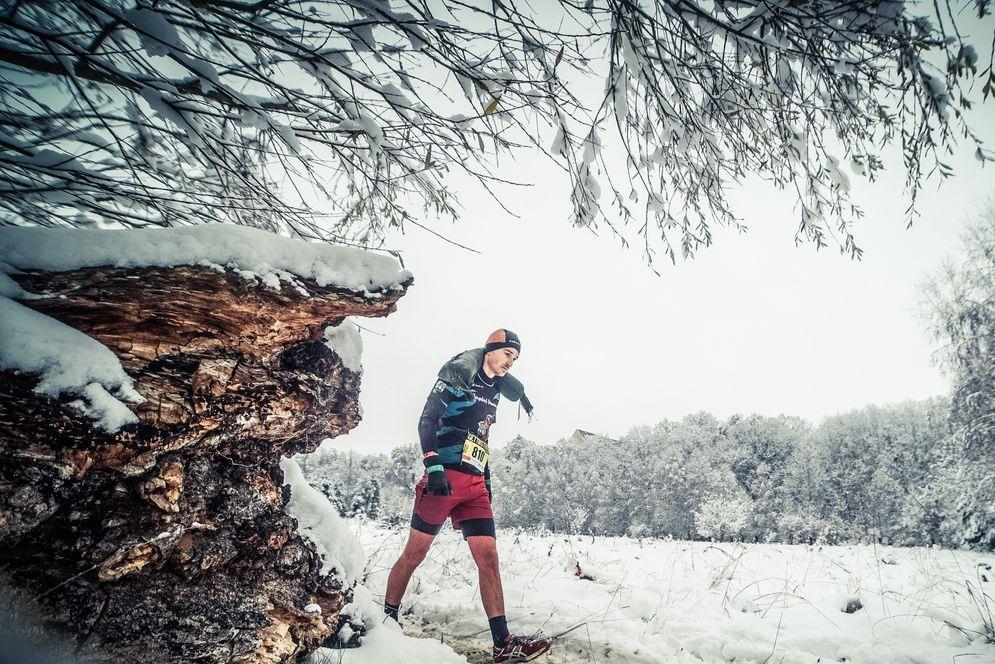
Getting Tough the Race or better known as the “Hell of Rudolstadt ”, is an extreme obstacle race which is happening every year in the first weekend of December in the east of Germany. It is the hardest obstacle race in Europe. This year was the 10th time of it happening and for me the third time attempting. Online there is not much information, so here you have everything you need to know!
Where is it located?
Getting Tough is located in the city called Rudolstadt. The city is not as big and 40km away from Erfurt in the state of Thuringia, one of the “new” states of Germany. For me, living in Hamburg, in the north of Germany, it is 450 km away.
Around Rudolstadt is not much, besides mountains and nature. In the city there is not that much to do. The old town of Rudolstadt is quite pretty, but really small and besides walking through it and eat a bit there is nothing to do. Especially in the winter, when the race is taking place it is too cold and sadly there is no christmas market, at least not in the last years and this year nether.
Where to stay the night?
This is an important point! When wanting to stay for the event nearby, then book early at a hotel or airbnb, because there are not many places available. The cheap places should be full quite soon after the race is finished, because many people are joining the year after again.
You will always find accommodations nearby, but they will cost more or be a little bit of a distance away. When being a bit away, it is important to have access to a car, taxi is also a thing, but super expensive. With a car the distances are not a problem, because also parking is for 5 Euro possible at the race.
The problem is public transportation. It is of course working, but not as good as in other places. Maybe hitchhiking is working, but standing so long in the cold and getting to the event is a bit risky.
What I want to say, it is in general a bit of a problem to get to the event when thinking of accommodation, because of not that high amount of options. Worse case it should be possible in Erfurt and Jena, which is just 40km away, it is just a bit more annoying in the first place.
What to expect?
When hearing that it is the hardest obstacle race in Europe, you can expect it to be not easy and tough, like the name says.
It is happening in winter, so cold temperatures and snow are also possible, like in this year. We had -2 degrees and a lot of snow! Even new snow overnight. With a lot of water at the obstacles, it is good to know that you are going to be wet for a long time.
After being through some obstacles at the beginning, you are going on the running part, which is with an elevation of around 1000m over a distance of about 19-20 kms. During the running it is possible to dry up a bit, before getting wet again. This time it will last until the end of the race, to complete the 24 kms in total.
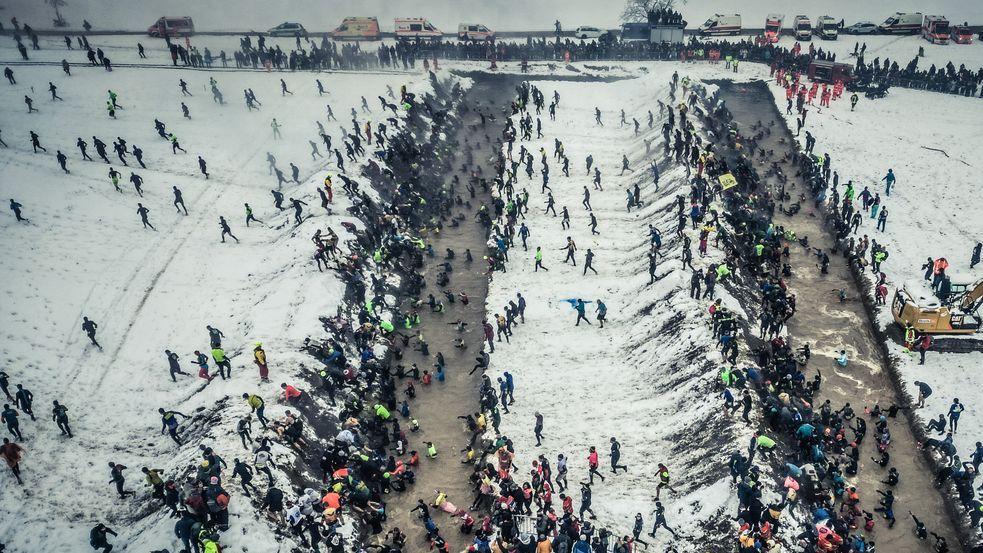
Including the 24kms are 150 obstacles included, which will be explained later a bit.
The “battlefield” is a place you will reach for the last two kilometers of the race. The battlefield is packed with obstacles, which will cost a lot of energy and strength from you. The cold will challenge you a lot, cramps are easy to get and will continue till the end of the race.
Most people are getting out of the race during the battlefield. Some just give up, because the mind was done and others, because the body was not able to work anymore, but the mind wanted to continue. The second thing was the thing for me during my first attempt, where the paramedics were carrying me out of the course with a body temperature of 33,5 degrees, which is really low.
A normal number for people leaving the race is around a third. This year around 800 from 1800 people left the race, which is a high number.
What equipment is recommended?
In general a wetsuit is helpful, but you need to think about it, that you also need to run in it, where too much wetsuit is just too hot and you are going to suffer a lot. To little wetsuit is also bad, because you are going to suffer from the cold to much, during the obstacles, but at least the running part would be easy with not much suffering. You can move your body more freely which is helpful a lot and the running part is from the general distance the biggest part. The time at the obstacles, can take a bit though.
My personal recommendation is quite clear:
- Wetsuit gloves
- Wetsuit socks
- Taking magnesium before and maybe taking some power gel for during the run
Everything more than those two wetsuit things is optional and for personal interest. It is important that hands and feeds are warm, because when they start to cool down, the whole body will. As further back, you can take that process as better. Also it will only work, when there is a bit of cold water in, which you should be getting at the first obstacle and little holes will ruin it.
In general, you need to feel comfortable in the clothes you are wearing. There are people doing it shirtless. This year, I was wearing besides the gloves and socks a wetsuit hat, a thin wetsuit shirt and wetsuit shorts. Wetsuit pants in general are, at least for me, super uncomfortable for running.
Also you should be looking at the weather, when it is too warm, for example 10 degrees, then you should be thinking of using thin layers or running with less wetsuit clothes. When it is like this year -2 degrees, then a bit more wetsuit layers could make you feel more comfortable.

What not to do
To increase your finishing during your first tough race, there are a few things, which could help you.
- Don’t wear a tube scarf, when jumping in the first water obstacle and you having it on, it feels like being waterboarded. After this obstacle, it will be so wet that it will be useless anyway. When having it underneath wetsuit clothes it could be able to be used, but just for the running part.
- Don’t over pace especially at the hills, because it is not a sprint and when your legs are done before the obstacles, it will be hard to finish at the end.
- Not too little and too little wetsuit parts on, which was explained above. When you know yourself and you know that you can handle a cold over a long period of time, then you can risk it, but I would not recommend it. Just don’t underestimate the cold.
- It has a lot to do with mental thinking as well, just because your mind is telling you that you can’t go further, that doesn’t mean that you are done.
- Be at the start a little bit faster, so you won’t be behind many people at the water obstacle, you will suffer more and it will be harder getting out of it. Because of all the people going over it, it will be just more muddy.
- When you are not the strongest runner, just walk up the hill. Many people are doing it so don’t worry about it.
How is the race setup?
Before everything is starting there will be a motivational speech from the organizers, before marching together to the starting point.
There will be a mass start on a meadow with all people, usually 1500 minimum but up to 3000. Everyone is standing next to each other and waiting for the start.
With the countdown finishing every person is starting to run over the meadow, to then jump in the water, which is right from the river nearby! It is not the warmest, but you have so much adrenaline, that you don’t care that much.
When you are on the way on the running track, you are trying to find your pace, to not be totally wasted after. During the running course there are few mountains, which you need to run up and down. While running, you are going to dry up a bit and stop freezing, in most cases. It is important to keep the power, because when you are coming to the obstacles, you need it.
Slowly you are running to the obstacles, the first real one will be the water obstacle from the beginning, but in it full length. It is around 300-400m long, with 1 – 1,4m of water, so standing is possible at most of the places, even when you are small. Also there are always people helping and supporting each other.
From this point on, it is over with getting dry and warm, you just need to get through. There are from that point around 100-120 obstacles waiting for you. Some are easier than others. When you reach the battlefield, there are around two kilometers of non stop obstacles, which is the challenge, before getting the medal. Getting the medal is the main goal of the race, so there is some reason to finish!

What obstacles are there?
There are general speaking obstacles. From running with a tire hills up, or carrying a piece of wood, to getting smashed with water from all sides. There are in total 150 obstacles, with the weather being one extra. In this year we had snow and minus degrees, which made it not easier.
For me the worst obstacle is the open air swimming pool. There is water from the nearby river in. You need to jump in the water and swim for a while, during this time it is possible for your body to cramp up. When you are done with the swimming, it is time for the real bad part, it is time to dive underneath the water a few times, to cross an obstacle. The water is feeling like hell in your face and it is just hurting.
When finishing with the open air swimming pool, few more obstacles are coming, which includes climbing over things. All the obstacles, where you need to move your leg up, are there to get you cramps, to have it harder and struggle more throughout the race. The good part there at least is that you will receive a hot cup of tea, which in most cases you are not able to feel anyway, but it is a nice thing. Probably the only nice thing.
Another bad obstacle this year were the wooden walls, which were around two meters high. You had to get over them and that 15 times in a roll. This would have been for a one time thing not that bad, but this many times behind each other is just a bad feeling. This whole race is for a big part a mental thing and in those moments, you will just struggle a lot. Especially, when you are having problems with cramps, which most people are going to have. It is just part of it.
Other types of obstacles are the crawling ones. Some of them are with little rocks, which will hurt a lot on your knees. Others are with sand, in our case snow, also with crawling through water, which is not really great, because usually you can’t rest during them.
Important is, that when you can’t do an obstacle, you need to do 10 burpees.
How can you finish?
There are a few things which could help you to finish. Training in general is a good thing to do for it, because as more fit you are physical, it will just help you. Same as doing running practices, because 24 kilometers with an elevation of 1000 m is not the easiest, even when excluding the obstacles.
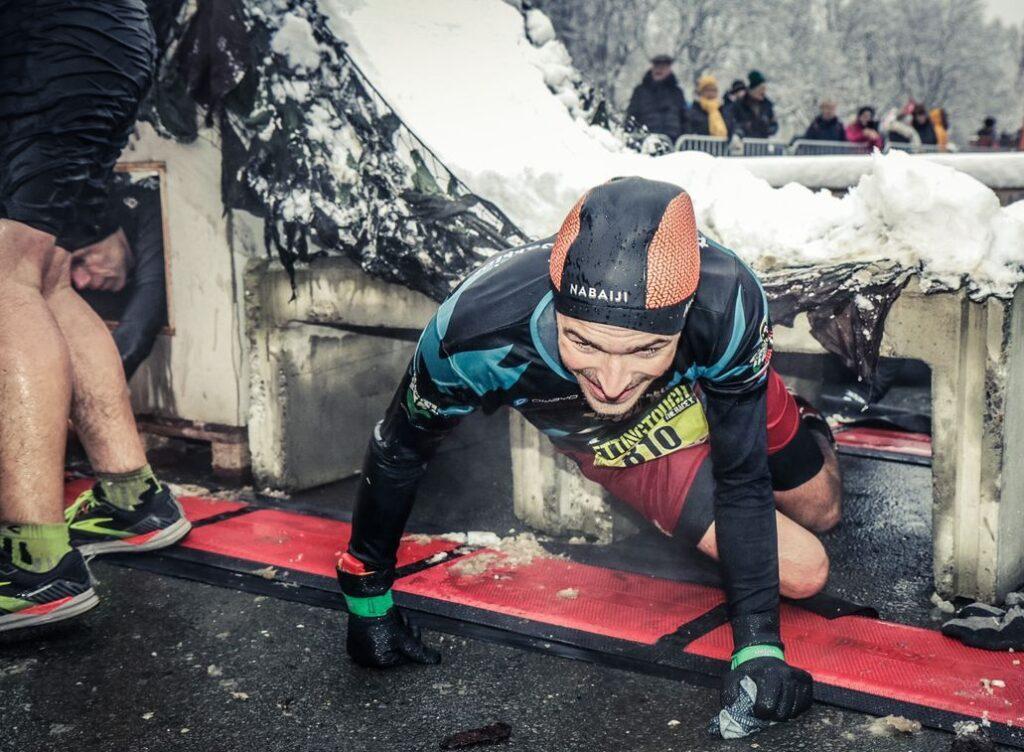
Things which are important and can help you to finish:
- It is not a sprint, so don’t worry about being slower than others. The goal is to finish and not to impress the other people. Better being slower at the running, then being completely exhausted at the end.
- Your body can do way more than you think. Just because your body is telling you that it is not possible anymore, that doesn’t mean that you need to stop. Shaking because of the cold is normal, but when you are still shaking and feeling the cold, that is still a good sign. When you start to not feel anything anymore, then you should start to worry. I have to write a good story later.
- Take as much help as you need, people wanting to help you, whenever you need it. There are no enemies, everyone is in your team.
- Try to avoid cramps as long as possible, so when the cramps say a little bit of hello, take it seriously and try to make it slower. As later you are getting real cramps as better, because it will become torture.
- Whenever you don’t need to use your legs, try to really not use them, because they will be the biggest obstacle of all, when there are problems happening.
- It is really just over, when you can’t get up!
- There are always people, who were doing the race before, ask them during the race things, when you need to know something. For a rough idea, how long you still need to run for example.
What to do after this race?
After receiving the medal, you are able to get medical treatment or get some food in general. I personally like to look over the course a bit and go then in the warm tent, to heat up a bit, before going home for example.
You are able to in general watch everything and walk everywhere, or just go home or in the city to eat something.
At the end of the day there is an after party. Before the party is really starting there will be the award ceremony held, which is quite nice to watch, but the real deal is after. The party goes the whole night and is a lot of fun. Just when you want to buy drinks, have cash with you, there is no card payment happening.
It feels just good going there, when you actually finish, at least you feel then, that it is right for you to be there. Also the entrance is free, when starting at the race, otherwise there is an entrance fee.
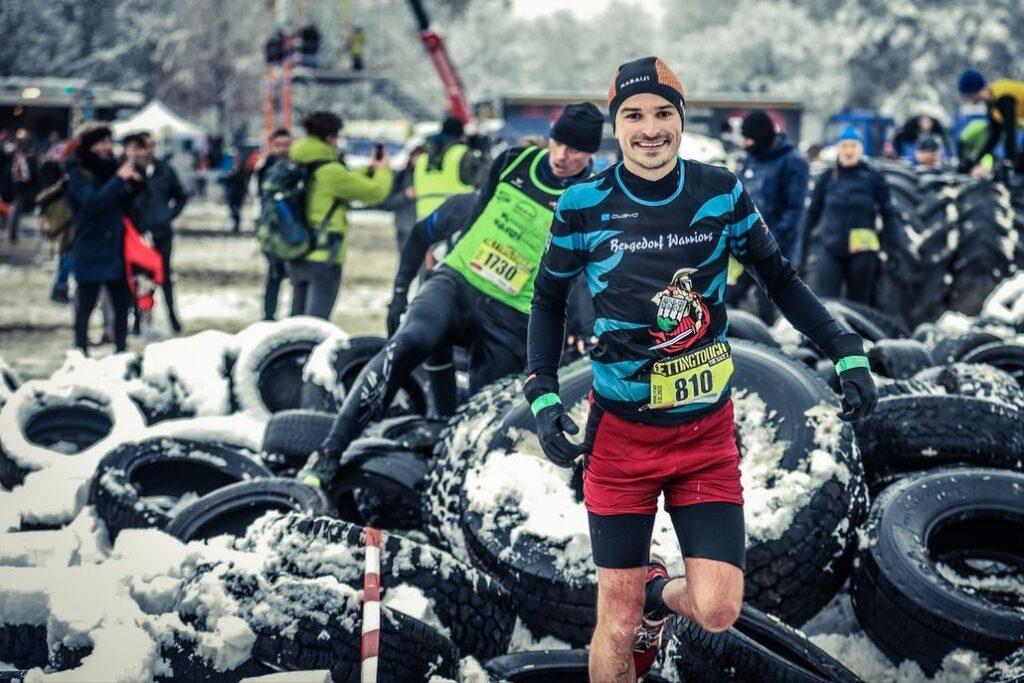
My bad experience?
I was doing ‘Getting Tough the Race” three times and finished twice, so I know what failure feels like. When I was doing the race the first time, I was not expecting it to be hard and maybe not even giving it a lot of respect. After being inside the first water obstacle, I felt already like that it would become hell. I was doing it with a friend and we both thought of giving up at this moment, but we didn’t tell each other, so we kept going.
Being back from the running track and being in the water again, my legs received their first cramp. Standing was hard and continuing too, because it is not easy for your legs to relax, while being under big pressure.
From that moment on, it got just worse and worse. I didn’t want to give up, because the finish wasn’t that far away anymore. Too much was done, to give up at this moment.
The cramps got worse and worse, there was nothing making it better. After the one cramp was gone, less than five minutes later, another one appeared.
I really felt the Hell of Rudolstadt. When reaching the stand with hot tea, my body was not feeling anything anymore. I spilled the hot tea on my skin, but there was no response there. It was time to just keep going. “The faster I am, the faster it is over”, was my thought.
I was less than a kilometer away from the finish line, with around 30 obstacles in my way. Important was, that I wanted to finish and then after a crawling obstacle, I received the cramps in my legs again. I told my friend to keep going, because I was just struggling too much and he was doing the same. A woman helped me, by giving my legs a quick massage and stretching my legs. The pain from the cramp was gone. So time to keep going, she helped me to get on my legs and after she let go. My body fell to the ground again.
The Paramedic came to me, to give me help, I didn’t want to. I wanted to finish, but the race was officially over for me.
They drove me to the medical tent, where they tried to heat me up. I arrived there with a body temperature of 33.5 degrees, which is super low. After around 20-30 minutes there, I was starting to feel the cold and the pain again. My friend also failed that race and that was just three obstacles before the finish. It doesn’t sound much, but when you are at that stage. There is no chance for you to finish anymore unless you can maybe crawl.
My experience this year
This year was a bit harder compared to the last ones. This was due to the snow and the cold temperatures. In general each race is getting slightly harder, which is still always similar.
I was having a few wetsuit clothes on, to get through it smoothly. One friend of mine from Austria was joining for the first time, so I wanted to help him. When the start signal was ringing and the crowd started running. I did the same and it felt like how I expected it, when going to war. Adrenaline high and then crawling in the snow was just painful. With red knees there was the jump in the water ahead. It was actually not as cold, as assumed, maybe because the temperature outside was way colder.
Due to my friend being slower than me, there was a long time waiting in between. It was fine, just being in the middle or even a bit behind felt weird. We were running 10km together, before he sent me away, so then for me the race really started. I was running a bit faster, which led to overtaking many people, but at one point I was not careful. I was cracking my ankle a bit, I couldn’t put my foot to the ground for two minutes. Such a painful feeling, luckily it didn’t last as long.
After knowing there was not that much of a distance left, I was starting to enjoy it. My time and position in the race was not important anymore, so I took everything simple. I didn’t want to hurt myself and just get the medal. I was actually excited to reach the long water obstacle, because due to the wetsuit I was super warm. It wasn’t as bad as the last few years for me until the open air swimming pool was coming. Right before jumping in that water, there was also another obstacle. There were water pipes, which were smashing water from all sides at you. From the top, front, back, bottom and the sides, no way to escape. That one was super painful.
Still I went through it and slowly getting slower to the finish line. The cramps were trying to introduce them self to me, but they didn’t make it through. I was not struggling with the cold and just looking forward to getting the medal and chill after.
Many people helped me, the same I did to others as well. Trying to motivate the beginners and pushing them through with me. When I saw the finish line I almost got my first cramp on that day. I luckily went through without which was such a great feeling. My body was still in pain but that was normal.
My friend, who is always doing it, got 24th place and my friend from Austria was going out of the race. It was because he listened to his body and not his mind. He was super sad about it at the end, because he knew that he had more energy at the end.
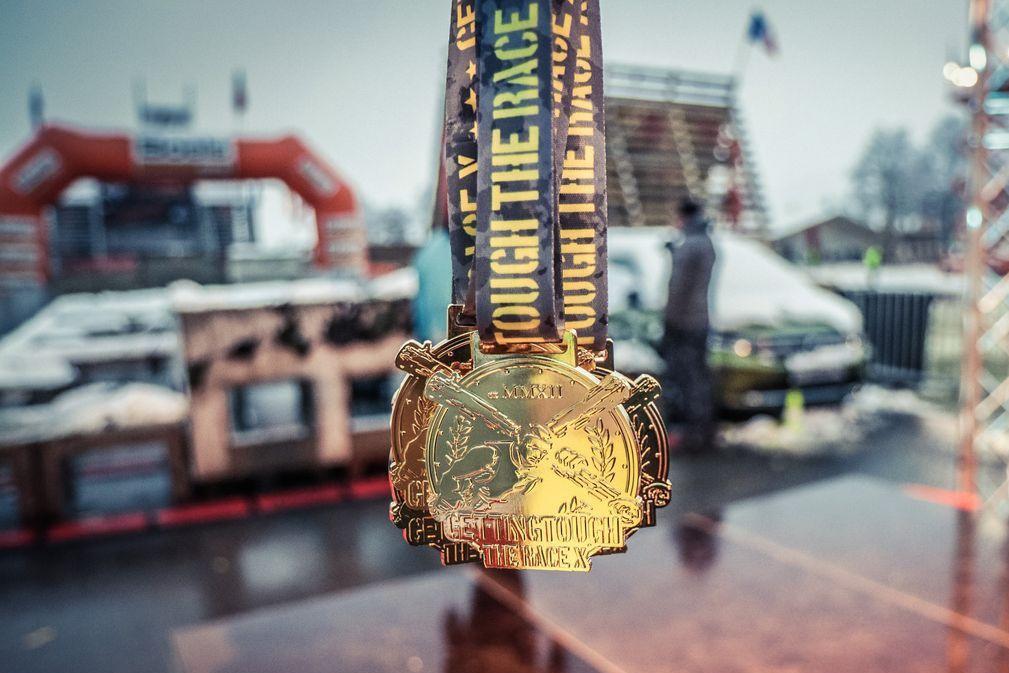
Summary
Getting Tough the Race is the hardest obstacle race in Europe. Probably also one of the hardest in the world. Many people are not making it and this every year. With over 150 obstacles and a distance of 24 kilometers it is also a lot of things to do.
It is more a mental thing, but being trained would not be bad. Every first weekend of December it is happening and it is a big event for a small city. When you finish, then you can be for sure proud of yourself and survive the Hell of Rudolstadt!
I have done it three times now and for sure not my last time, it feels good to overcome your body and achieve something crazy in many opinions. So when you are ready to do something crazy and memorable this is some good thing for the winter. This is just one of the many crazy things you are able to do in this world, can’t wait to talk about more!
I would love to hear your experiences about this place, or questions. Share it with me in the comments.



